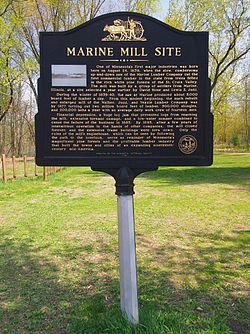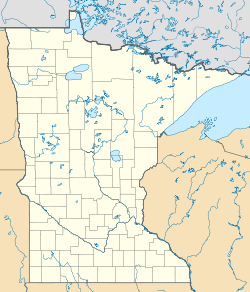Marine Mill
|
Marine Mill Site
|
|

The Marine Mill Site historical marker
|
|
| Location | Judd Street, Marine on St. Croix, Minnesota |
|---|---|
| Coordinates | 45°11′53″N 92°46′6″W / 45.19806°N 92.76833°WCoordinates: 45°11′53″N 92°46′6″W / 45.19806°N 92.76833°W |
| Area | 7 acres (2.8 ha) |
| Built | 1839–1873 |
| Part of | Marine on St. Croix Historic District (#74001043) |
| MPS | Washington County MRA (AD) |
| NRHP Reference # | 70000311 |
| Designated NRHP | January 26, 1970 |
The Marine Mill was the first commercial sawmill in what became the U.S. state of Minnesota, established in 1839. Now in ruins, it is currently a historic site managed by the city of Marine on St. Croix in partnership with the Minnesota Historical Society. It was listed on the National Register of Historic Places as the Marine Mill Site in 1970 for having state-level significance in the themes of exploration/settlement, industry, and transportation. It was nominated for being the birthplace of the region's seminal industry—lumbering—and a major landing on its crucial transportation route, the St. Croix River. The site is also a contributing property to the Marine on St. Croix Historic District.
Lewis Judd and David Hone identified the site, with a swift-flowing stream for power and a bank suitable for steamboats, as ideal for a sawmill during an 1838 scouting expedition. They were members of a group of New Englanders who had come west in search of new lumbering opportunities. They returned to their home base in Marine, Illinois, and chartered the Marine Lumber Company with six other business partners. In May 1839 the eight partners, plus one member's wife and two children, arrived by steamboat with a load of milling machinery. In just 90 days they had completed their sawmill, cutting lumber for the first time on August 24. The land, only purchased by the United States in 1837 through treaties with the Ojibwe and Dakota people, was not yet legally open to settlement.
The original mill cut less than 5,000 feet (1,500 m) of lumber per day, so it was replaced in 1852 with a larger mill powered by a 40-foot (12 m) water wheel. However the whole building burned down in a fire in September 1863, idling workers for three years until a replacement was constructed in 1866. To keep pace with its competitors, that mill was almost completely remodeled in 1873, at which point it could cut up to 30,000 feet (9,100 m) per day.
...
Wikipedia


